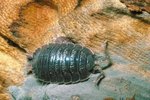
In their natural "wild" habitat, the giant panda is a solitary animal avoiding human contact. This makes it challenging for researchers to study how these endangered critters secure their food each day. To better understand how pandas acquire nourishment to aid in habitat preservation, zoo researchers have conducted testing to identify the foraging and eating habits of the giant panda.
Tearing and Shredding Bamboo
The fact that the carnivorous giant panda bears primarily eat bamboo -- a wood product and not a meat source -- forces them to be engaged in eating most of the day. It's because bamboo is low in nutrients, according to the San Diego Zoo, where giant pandas have been studied since 1987. Thus, they need a lot of it to meet their nutritional requirements. Pandas get bamboo as they grasp stalks of bamboo with their five fingers and specialized wrist similar to that of a raccoon and peel off the outer layers. They use their strong jaws, well-developed cheek muscles and sharp incisors to tear apart the soft inner tissues of bamboo stalk and begin digestion.
Foraging Behavior
When living in the wild, giant pandas secure their food source by foraging. It is a type of directed wandering in which the giant panda is constantly in search of plant material to consume. In order to prove and better understand this critter's use of foraging, researchers at the Smithsonian National Zoological Park placed full feed containers in a circle inside the panda enclosure. They watched to see if the pandas would go around the circle emptying each feeder before moving on -- a behavior more indicative of foraging -- or if the pandas would travel across the circle as they ate. The pandas moved from feeder to feeder following the circular placement of the feeders leading researchers to believe the animals followed one of the basic rules of foraging: use the least amount of energy to consume the greatest amount of food.
Food For The Young
Because the birth rate among giant pandas is very low, zoo researchers take extra precaution in feeding the young born in captivity. These baby pandas getting their food from their caretakers receive a specialized milk formula of boiled rice and synthesized vitamins. This formula is designed to mimic the milk they would obtain from their mother for the first six months of life if living in the wild. Anywhere between seven and nine months, the young pandas are offered the more tender portions of bamboo along with sugar cane, carrots, apples and sweet potatoes.
Other Than Bamboo
In the wild, as part of their foraging activity, giant pandas will eat fish, flowers and small animals that are available. The how of this eating is as simple as using their fingers and specialized wrist to snag fish from streams, munching on flowers and trapping small animals -- again with their fingers and wrist -- and using their jaws to kill the prey and begin chewing on it. Zookeepers honor this aspect of the giant panda diet by putting milk, eggs and ground beef in a bread.
References
Photo Credits
-
Tom Brakefield/Stockbyte/Getty Images
Writer Bio
Amy M. Armstrong is a former community news journalist with more than 15 years of experience writing features and covering school districts. She has received more than 40 awards for excellence in journalism and photography. She holds a Bachelor of Arts in communications from Washington State University. Armstrong grew up on a dairy farm in western Washington and wrote agricultural news while in college.




